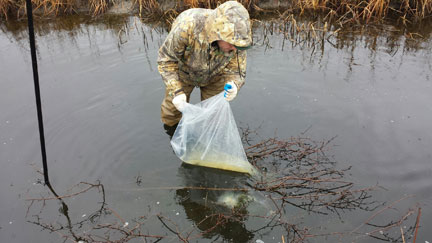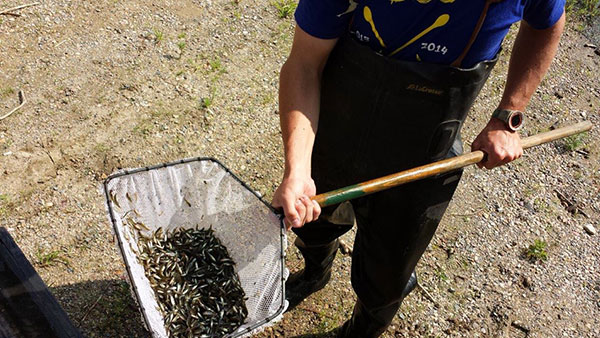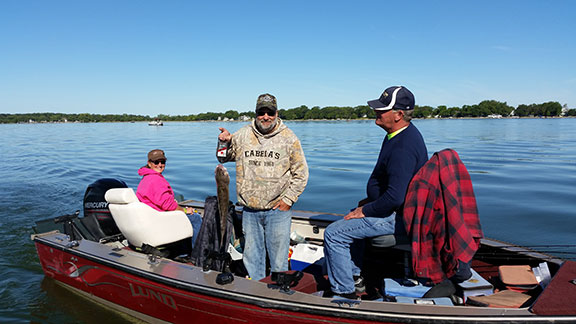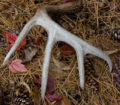By Steve Weisman
The Iowa Great Lakes are home to approximately 30 native species of aquatic vegetation. This vegetation is very important to the health and well being of our lakes.
However, over the past few weeks, I have noticed huge expanses of aquatic vegetation surrounding the shallow edges on the north end of East Lake Okoboji? It’s pretty incredible, something I don’t recollect seeing before.
So, I asked DNR Fisheries Biologist Mike Hawkins, “Mike what is that emergent water vegetation on the north end of East Lake?”
His response? “It’s curly-leaf pondweed. It is an exotic plant, but it has been in the United States since the mid-1800s. It has been in the Iowa Great Lakes for decades, but it is probably more noticeable this year because of the cool spring and the clear water conditions, which was the perfect growing environment. It is easy to identify because of its wavy long leaves.”
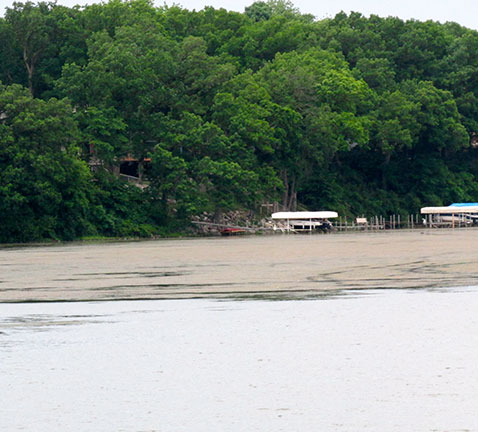
(photo by Steve Weisman) Curly-leaf pondweed blankets the shallows on this section of East Lake Okoboji.
Curly-leaf facts
Here are some facts compiled by the Iowa DNR. Curly-leaf pondweed is native to Eurasia, Africa, and Australia, and it has spread aggressively since it was first introduced in the mid 1800’s to North America. By 1950, most of the United States was infested, and it was first reported on the Mississippi River in 1944. This aquatic plant can now be found in 48 states and has become invasive in many areas.
Curly-leaf pondweed grows in standing water in lakes, ponds, and streams. It grows from the shoreline to depths of about 12 feet. It’s found in several locations throughout the state of Iowa.
As Hawkins says, it does provide habitat, and in some ways it can be considered better than nothing. At the same time, it as an exotic, and it can out-compete native aquatic plants, because it starts growing so early. As you can see looking across the north end of East Okoboji, it really develops a dense stand. Obviously, when it becomes this thick, it definitely causes problems for activities such as fishing, swimming and boating.
The bad news is that the plant is often spread around by humans as they travel through the plants with their boats, personal watercraft, etc. It is often transported to other parts of the body of water and even to other lakes as pieces of curly-leaf cling to boats, motors and trailers.
Curly-leaf growing season
The plant’s unique life cycle is what gives it an advantage over many of our native aquatic plants. It actually becomes active during late ice conditions, so it is up and going shortly after ice-out. While the plant has a relatively short growing season, under conditions like this year, it will spread and form a dense mat that can limit both human recreation and the growth of native aquatic plants. Curly-leaf pondweed begins to die back by early to mid-July. Unfortunately, these die-offs can lead to depleted oxygen conditions and mats of decaying plant material washing up on shorelines. An increase in nutrients can also cause a blue-green algae bloom. Known as cyanobacteria, blue-green algae can be pretty ugly and stinky.
Control
As for control, Hawkins says, “Researchers have investigated many ways of trying to control this aquatic plant but have only had limited success. Aquatic herbicides have provided some control, but their use can be problematic in public waterbodies, especially those associated with drinking water supplies like the Iowa Great Lakes.”
Hawkins goes on to say, “Pesticide application to public water bodies is illegal and strictly controlled. Mechanical removal or cutting can be a solution for homeowners, and permits are available through the DNR for this type of activity. Usually these permits can be granted in just a day or two.”
More than ever, I think people are beginning to see that preventing the spread of invasive exotics is so very important! Here are some simple, yet effective ways to do this.
Always check for and remove plants, mud and debris from boats, trailers, clothing, and equipment before leaving a water body. Drain all water from bait buckets, bilges, and live wells before transporting to new waters. Drain all water from bait buckets, bilges and livewells before transporting to new areas. Clean all gear and equipment with hot water or let boats and equipment dry thoroughly for several days before entering a new body of water.


